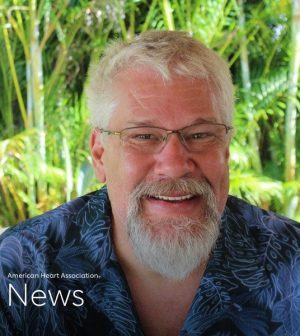- See What Saffron Can Do for Sleep and Heart Health
- 6 Common Mistakes to Avoid Before Your Physical
- Can Sweating Really Help You Beat a Cold?
- Strengthening Your Relationship: Practical Strategies
- Skip Storing This Everyday Product in the Fridge Door
- Green Tea + B3 Pairing May Boost Brain Health
- Navigating Your Midlife Crisis: Embracing New Possibilities
- City Raccoons Showing Signs of Domestication
- Mapping the Exposome: Science Broadens Focus to Environmental Disease Triggers
- One Week Less on Social Media Linked to Better Mental Health
AHA News: While Home Recovering From COVID-19, She Saved Her Husband’s Life

THURSDAY, Feb. 23, 2023 (American Heart Association News) — One day last July, Mike Button settled into his home office, ready to start catching up on the backlog of things that had accumulated over his latest prolonged stretch away from work.
In April, his mom had died following a prolonged illness. Around the same time, he was diagnosed with congestive heart failure and began taking medication to strengthen his heart. He’d recently gotten back from his mother’s memorial service in Detroit. Then came a bout of COVID-19 and, while recovering, one of his dogs died right in front of him.
Back at the desk of his home in Palm Beach Gardens, Florida, he felt a little tired. Everything else seemed normal.
His wife, Stephanie, was recovering from her own case of COVID-19. She was healthy enough to return to her office, but she stayed home a few more days at the request of a co-worker with a newborn.
That afternoon, Stephanie walked into Mike’s office to ask him a question.
He looked up and said, “I feel dizzy.”
He then saw a blue static line, the kind seen on old televisions when they were being turned off.
The next instant, he slumped over in his chair.
“Mike! Mike!” Stephanie yelled, shaking him.
He wasn’t moving or breathing. He was in cardiac arrest.
Stephanie called 911.
“Do you know CPR?” the dispatcher asked.
She’d been trained several times. But in her panic, she couldn’t remember a thing.
“No,” she said.
Stephanie turned on speakerphone and the dispatcher talked her through it.
First, she had to get Mike on the ground. She grabbed his office chair by one of the arms, pulling it over sideways until he tumbled to the floor.
Next, she was told to give her husband chest compressions until help arrived. They were there in just under five minutes.
The EMTs connected Mike to an automated external defibrillator, or AED. The portable device can help restart a heart that’s stopped beating. After each of the first two shocks, Mike received CPR from a mechanical CPR device designed to deliver continuous chest compressions. The third shock from the AED triggered a sustainable rhythm.
Mike spent two days in a medically induced coma, a gentle environment that allowed his brain and body to heal. Stephanie was by his side, working on her laptop and talking to him.
When she arrived on the third day, he was already awake. A breathing tube was removed. Mike looked at her said, “What happened to me? Why am I here?”
The coherent thoughts were a huge relief to Stephanie. It indicated that he didn’t have brain damage caused by however long he went without oxygen.
Cardiac arrest is a glitch in the heart’s electrical system. Doctors were never able to trace why it happened to Mike. However, they said it could be related to his recent diagnosis of congestive heart failure.
After the cardiac arrest, Mike underwent cardiac resynchronization therapy. A half-dollar-sized pacemaker was implanted in his chest and connected to his heart. Should his heart rhythm get out of whack, the device can correct it – thus the term “resynchronization.”
Two weeks later, Mike was back at work. It took about another month to recover from everything else he went through.
“The pain is simply a reminder that you’re not dead yet,” Mike said. “It was well worth it.”
During his recovery, Mike felt overwhelmed with gratitude and awe that his life was spared.
“I’d start thinking about it and get emotional,” he said. “It’s hard to imagine that maybe I wouldn’t have been around to watch our grandson grow up.”
Stephanie calls the cardiac arrest “definitely the worst day of my life and best day of my life.”
“It clearly was not his time,” she said. “It was a miracle that I was standing in front of him when it happened.”
Mike calls Stephanie his hero.
“Of course, the paramedics are also my heroes, but without Stephanie’s quick actions they wouldn’t have had much to work with,” he said.
In October, the couple was able to meet Mike’s other lifesavers at an awards and appreciation ceremony held by the city of Palm Beach Gardens.
“They had paramedics, firefighters, nurses and doctors, and they all got awards,” Stephanie said. “It was amazing for Mike and me to be able to thank them in person.”
Stephanie also received a “Citizen Life Saving Award” from the city.
She and Mike now spread the word about CPR, including taking refresher courses organized by Stephanie’s women’s group at their church.
“I tell everybody that CPR is the most important thing you can know,” Mike said.
American Heart Association News covers heart and brain health. Not all views expressed in this story reflect the official position of the American Heart Association. Copyright is owned or held by the American Heart Association, Inc., and all rights are reserved. If you have questions or comments about this story, please email editor@heart.org.
By Diane Daniel, American Heart Association News
Copyright © 2025 HealthDay. All rights reserved.










